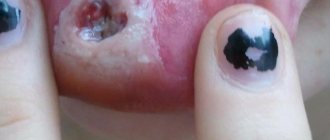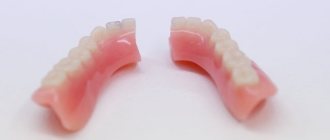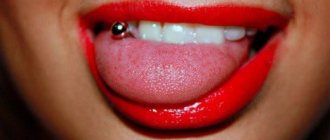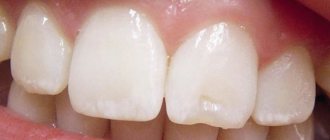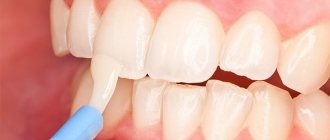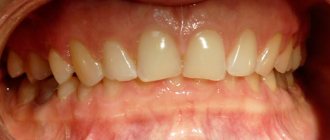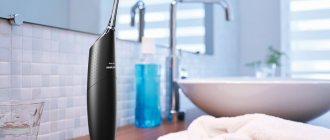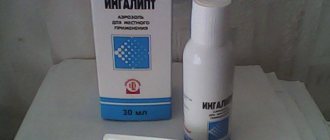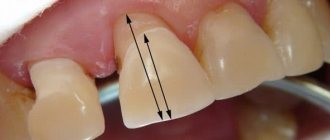Prosthetics using dental gold has gained immense popularity due to the unique properties of this metal. Thus, gold and its alloys can easily be processed in any way - high-quality polishing of products allows you to ensure a tight fit of the crowns to the soft tissues, eliminating the subsequent development of inflammatory processes and caries. Gold teeth are not susceptible to “attacks” of food dyes, do not oxidize, and are resistant to corrosive processes.
The main advantage of gold teeth is that this is the only type of crown that does not cause individual intolerance and does not lead to galvanosis. Gold and its alloys have good fluidity, which makes it possible to produce dentures that are as close in shape as possible to natural units of the dentition. Gold crowns on teeth look aesthetically pleasing, wear well, and are quickly installed.
How are dentures made?
If it is assumed that a gold tooth will be installed in the smile area, then the precious metal frame is lined with ceramic mass. Pure gold is not used when casting crowns. To make the prosthesis as resistant to external “attacks” as possible and to hold well, palladium and platinum are added to the alloy.
Removable gold dentures - a newfangled dental trend
Recently, designs decorated with stones and gold figurines (as in the photo above) have become especially popular in dentistry. Not long ago, the possibility of prosthetics using removable gold products appeared (they are not installed for medical reasons, but only for aesthetic reasons).
Gold crowns on teeth
Prosthetics using dental gold has gained immense popularity due to the unique properties of this metal. Thus, gold and its alloys can easily be processed in any way - high-quality polishing of products allows you to ensure a tight fit of the crowns to the soft tissues, eliminating the subsequent development of inflammatory processes and caries. Gold teeth are not susceptible to “attacks” of food dyes, do not oxidize, and are resistant to corrosive processes.
The main advantage of gold teeth is that this is the only type of crown that does not cause individual intolerance and does not lead to galvanosis. Gold and its alloys have good fluidity, which makes it possible to produce dentures that are as close in shape as possible to natural units of the dentition. Gold crowns on teeth look aesthetically pleasing, wear well, and are quickly installed.
Sooner or later, the time comes when darkened and tarnished gold jewelry ceases to please the eye. I would like to put the products in order, restore their attractiveness, and even without unnecessary financial investments. Below we will describe life hacks that will help you clean gold at home using improvised means, without giving it into the wrong hands.
Gold jewelry
The most common reasons why gold darkens or turns black:
- the share of gold in the jewelry: with a standard of 585 and below, the products will darken faster;
- the decoration is new and the top polishing layer applied by the manufacturer for a better presentation is darkening - the problem is temporary and will disappear as this layer wears off;
- wearing conditions: exposure to aggressive environments, mercury, iodine, pollution.
In any case, if gold items have turned black, they can and should be cleaned.
It never hurts to know how to quickly clean gold at home. For example, in case there are literally a few minutes before leaving, and the only pair of earrings or pendant that matches the look looks, to put it mildly, unmarketable. There are always suitable means for cleaning gold at home - don’t waste time and restore the attractiveness of your jewelry.
Ammonia
Cleaning gold at home with ammonia or ammonia is the easiest way to get rid of cloudiness of the precious metal and stains on jewelry. To effectively clean gold from blackness, you need to make a solution of water and ammonia with the addition of shampoo. Recommended proportions for a small container of warm water: 0.5 tsp.
Gold rings in ammonia solution
In this way, you can soak gold with some stones: the ammonia solution perfectly removes dirt and oxides from hard-to-reach places. To dry, simply place the jewelry on a paper napkin or towel.
Hydrogen peroxide
Hydrogen peroxide is also an effective and affordable liquid for cleaning gold. For minor stains, it is enough to wipe the jewelry with a cloth soaked in peroxide. In other cases, a more aggressive method is recommended:
- Make a solution: 1 glass of warm water, 30 mg of hydrogen peroxide (3%), 1 tsp. ammonia, a small amount of liquid soap (by eye).
- Mix the ingredients thoroughly.
- Immerse gold items in a container with the solution and leave for 3-5 hours.
- Rinse the jewelry with plain water and dry it on a napkin.
You can clean a gold chain, bracelet or ring using regular white 9% or apple cider vinegar, with the addition of soda or lemon. Please note that only yellow and red gold can be cleaned with vinegar; this method is unacceptable for white, matte or inlaid with stones.
You can use a toothbrush to clean gold.
In some cases, it is enough to simply soak the products in vinegar for 10-15 minutes, then rinse with water; in others, you will need to brush the surface with a toothbrush.
Baking soda will help clean gold from dirt, but it does not always cope with difficult stains. Most often, boiling with soda is used for cleaning:
- Place foil at the bottom of a small container of water and place gold on it.
- Heat water and add soda - 1 tbsp. water 1 tbsp. soda
- Boil for a few minutes.
- Clean with a brush.
- Rinse with plain water and dry.
We suggest you familiarize yourself with which trees purify the air best.
Soda is not used for cleaning jewelry with inserts: it can cause tarnishing of the stones, and the soda solution can also remain in hard-to-reach places of fastenings with a whitish coating.
Salt is typically used as an addition to vinegar or baking soda cleaning solutions. Due to the strong abrasive nature of salt, we do not recommend mechanical cleaning of soft gold items.
Lemon acid
To dissolve plaque, you can clean gold in citric acid:
- Dilute citric acid in boiling water;
- immerse the products in the solution for 5-6 minutes;
- rinse and dry jewelry.
Toothpaste
You can clean darkened gold at home even with the most ordinary toothpaste. Using a soft brush, evenly distribute the paste over the surface of the decoration and remove dirt with gentle movements.
You can clean gold with toothpaste
Paste GOI
This is a special composition for cleaning gold from impurities and giving it shine, developed by the State Optical Institute. There are 4 types of paste; you should choose a specific option based on the expected result:
- No. 1, No. 2 – polishing to a mirror effect;
- No. 3 – cleaning of medium complexity to an even matte shine;
- No. 4 – rough cleaning with surface grinding and removal of scratches.
Method of use: as with toothpaste. GOI paste is not used for white gold.
There is a fundamental difference in cleaning a smooth ring or a complex piece of jewelry inlaid with stones. To effectively clean gold jewelry with stones at home, it is recommended to use the cleaning methods described above with ammonia alcohol, paste, and liquid soap. As a rule, using a soft brush to clean hard-to-reach areas is indispensable.
Cleaning gold with stones
When cleaning such jewelry, you should take care not only of the condition of the gold, but also of the jewelry inserts. Jewelers recommend using different products for different types of gemstones:
- a ring with topaz or any other gold jewelry with this stone will shine after soaking for 20 minutes in water with a couple of drops of dishwashing detergent diluted in it;
- acids should not be used to clean jewelry with chrysolite;
- earrings with stones such as emerald, ruby or sapphire can be easily cleaned in warm soapy water - hot water is contraindicated for these stones;
- Cleaning gold items with cubic zirconia is done using ammonia, toothpaste without abrasives or any washing powder.
Not all classical methods are suitable for cleaning jewelry made of white gold, which is an alloy of precious metal with copper, palladium or nickel - in particular, any vinegar is contraindicated.
White gold cleaning
White gold with inlay cannot be boiled: high temperature will weaken and even deform the places where the stones are attached. For glued stones, cleaning with immersion in aqueous solutions is not used. White gold with diamonds can be cleaned without contact with the stones: simply wipe them with a soft cloth - this is often enough to restore the shine. If the shine has not returned, use the standard toothpaste cleaning described above, then wipe the product dry.
Of course, you cannot use any aggressive agents or abrasive cleaning in this case - there is a risk of damaging the thin layer of gold plating. It is better to clean a gold-plated chain, bracelet or ring in the following way:
- Prepare a solution: 1 liter of warm water, 1 tsp. soap shavings, 5-6 drops of ammonia.
- Soak the jewelry for half an hour - they should be completely immersed in the solution.
- Rinse in running water, dry on a napkin or towel.
- Polish with a suede cloth.
Medical gold is an alloy of brass, silver, copper, titanium and zinc, but there may be no gold in it at all: the alloy already has a noble “golden” luster. Products made from medical gold are durable, not subject to external mechanical influences, and due to the special technology of polishing and sputtering, they practically do not darken, do not lose shine, and do not change color.
- If it is necessary to clean such jewelry from contamination, the following methods are used:
- Rinse in a solution (2 drops of shampoo or liquid soap per 0.5 cup of water) and clean the product with a soft brush.
- To remove dust, wipe the product with a cotton swab soaked in beer; there is no need to rinse with water after this.
- Wipe the decoration with table vinegar, and then be sure to rinse in running water.
In some cases, it is better to entrust the polishing of jewelry with complex designs to professionals, but you can handle simple jewelry yourself. To make a gold ring shine like new, use the following techniques:
- Soak the jewelry in hot water with shampoo or soap for 7-8 hours, and then polish with a soft toothbrush. The method is suitable for both shiny and matte gold.
- Soaking for 10 hours in an ammonia solution (25%), which can be purchased at a pharmacy, will help to add shine to gold.
- Polishing gold from scratches is done using a cleaning paste for gold items - factory-made or homemade from Vaseline, powdered white chalk, water and soap shavings. Buff with a soft toothbrush without applying pressure.
- Apply GOI paste to the felt, wipe the product with unidirectional movements without pressure: this will help restore shine and effectively polish scuffs and scratches.
We suggest you read: How to remove the skin from a tomato in the microwave
Indications for prosthetics
Types of dental prosthetics
It is recommended to give preference to gold teeth:
- if necessary, restore the original shape and size of natural units as accurately as possible;
- to correct significant malocclusions, strengthen individual teeth;
- for the purpose of restoration of chewing units (invisible when smiling and talking);
- in the presence of bruxism, as well as bad habits of chewing hard objects, opening bottles with teeth.
Aladdin remedy
A Russian-made product from a series of preparations for the care of jewelry. It allows you to clean gold at home almost at a professional level. The drug includes liquid solutions and napkins (read about napkins below).
Liquid product "Aladdin" is offered in packaging of 50, 100, 200 ml and in liter canisters. Small jars are good for home use (a 50 ml container is enough for at least six months of use if you clean gold items once a week. In reality, this does not happen and the gold cleaning product lasts for an even longer period).
The kit, in addition to the jar with the solution, includes a mini-basket and a brush, which are located inside the jar. With their use, no cleaning liquid gets on your hands at all. It’s easy to use Aladdin:
- Open the container and place the gold items in the mesh.
- Dip them into the liquid until they are completely covered.
- After a few seconds, remove the jewelry from the cleaning product and, if necessary, use a brush to reach hard-to-reach raised areas.
- Wash them with cool water and dry them with a dry soft cloth.
The cost of “Aladdin” is encouraging: 50 ml of the drug costs only 60–70 rubles.
The Aladdin product is suitable for cleaning any gold items, including those with inorganic stones, as well as platinum jewelry.
Installation
The tooth is prepared for subsequent preparation (a picture is taken, caries is treated, the old filling is replaced, the composite is restored on the pin, etc.). Next, injectable local anesthesia is administered and the “working” unit is ground (to the thickness of the crown). After this, the doctor makes impressions of both jaws and sends them to the laboratory to make plaster models of teeth. Based on plaster prototypes, artificial crowns are formed and (if necessary) tried on. The last stage is fixation of the gold prosthesis on the tooth stump using special cement.
Crowns made of gold alloy are durable, wear-resistant, hypoallergenic, and do not lead to the development of galvanosis in the oral cavity
Important! Upon completion of prosthetics, the doctor must give recommendations on how to clean gold crowns from accumulated plaque.
Useful tips
By caring for your gold properly, you can avoid tarnishing, tarnishing, and scratching your favorite jewelry. Here are some useful tips:
- Wipe products with a soft, dry cloth if they have been exposed to moisture.
- Remove gold jewelry before playing sports, doing household chores, showering, or using cosmetics.
- Keep gold jewelry away from sunlight and medications.
- Clean gold as a preventative measure at least once every 2 months.
- When purchasing gold cleaning products, always check to see if they can be used on stones.
- Use ultrasonic cleaning at home with caution - some stones may crack.
Gold jewelry is best stored in a padded box
Treat gold jewelry with care, clean it regularly from dirt, and it will delight you with its dazzling shine for a long time.
We suggest you familiarize yourself with How to clean gold at home: the better, effective recipes for quick solutions to clean jewelry
Advantages
Gold crowns have many advantages compared to other materials used for prosthetics:
- full compatibility with soft tissues of the oral cavity;
- the absence of any harmful additives in the alloy - as a result, there is no risk of an allergic reaction, irritation and other unpleasant manifestations on the oral mucosa;
- high strength – for the manufacture of crowns, gold of the highest standard is used, which is resistant to any damage;
- due to the softness of the alloy, antagonist teeth are not injured;
- After prosthetics, almost complete “fusion” of the natural unit and the gold crown occurs.
Daily care of gold
https://www.youtube.com/watch?v=H4y4KIX5zHw
Factors that contribute to the darkening of gold include:
- Sun rays;
- contacts with aggressive household chemicals;
- prolonged contact with moisture, especially sweat;
- Iodine is an extremely dangerous substance for gold, so avoid any contact of your jewelry with it. Once iodine gets on the surface of the jewelry, the gold darkens, and it is extremely difficult to get rid of this stain;
- mechanical damage (impacts, scratches).
Gold jewelry will last much longer if
you do not forget about the rules of wearing it. To avoid having to regularly and thoroughly clean your jewelry, you need to pay attention to storing, wearing and protecting it from harmful influences. Not worth it:
- wear jewelry in the bathhouse, sauna, gym;
- leave them on the windowsill on a clear sunny day;
- wear jewelry while cleaning the house or working in the garden;
- take gold items to the beach and also to the pool;
- leave jewelry on yourself during skin care procedures (applying cream, washing, peeling, etc.);
- wear gold during heavy physical work (for example, in a factory, where there is a risk of knocking or scratching the product).
Precautionary measures
Dental gold is not used for dental prosthetics in patients with mental disorders or chronic periodontitis. Contraindications to the installation of gold dentures are the period of pregnancy in women, as well as the patient’s age under 16 years. Naturally, gold prostheses made of gold are also not placed on mammary units. For the first few days after prosthetics, you should refrain from eating hard foods.
In some patients, the adaptation period is associated with certain discomfort - increased sensitivity of the “working” tooth, pain when biting. In a number of clinical cases, the fixing cement is washed out from under the prosthesis - this can lead to the development of local inflammatory processes and caries, and as a result, the crown may simply fall out. In this case, you should contact an orthopedic dentist - he will decide what can be done (remove the remaining cement, replace it with new material, insert the crown in place).
How gold crowns are made
There are two types of them according to the manufacturing method - stamped and cast. For stamped ones, standard blanks are used - sleeves. The crowns are finished in the mouth before being cemented into place.
Cast gold crowns are made more accurately. Individual wax models are used for them. To install them, the teeth are ground down more than for stamped crowns.
Crowns are made in stages:
- teeth are prepared;
- anesthesia is applied;
- grinding is carried out;
- impressions are taken;
- models are made from plaster;
- prototypes of crowns are created on models;
- are tried on and adjusted to the teeth;
- The crown is fixed to the tooth with cement.
In what cases are gold crowns needed?
- To restore the anatomical shape of the tooth.
- When restoring tooth function.
- If you need to strengthen your teeth.
- To improve aesthetics.
- In order to restore chewing functions.
- With a pronounced bite, clenching of teeth, grinding them.
When should you not place gold crowns?
- Until the age of 16.
- For periodontitis.
- If you have mental disorders.
- During pregnancy.
After the gold crowns are placed, the process of recovery and rehabilitation begins. You can eat and drink, but do not consume solid food right away.
Pay attention to the feeling of discomfort, changes in tooth sensitivity to cold and hot. To eliminate this problem, it is recommended to brush your teeth with a toothpaste for sensitive teeth.
If the crown is set high, you may experience pain when biting into food. The dentist will quickly correct the deficiency. There may be cases of washing out of the cement that strengthens the crown, weakening of the fixation, even to the point of falling out.
Let's look at the main advantages:
- Such dentures do not have an abrasive effect on other teeth, thereby preventing their wear.
- Gold itself is beneficial for teeth, the whole body, and the oral cavity, improving its microflora.
- Gold structures are inert to saliva and food composition.
- Dentures do not cause allergies and are completely safe for humans. They will last longer than products made from other metals.
- Teeth are better preserved under crowns; they cope well with the chewing process.
- The structures themselves, made of gold, cannot break or splinter.
DETAILS: Allergy to metal ceramics - Allergy
Cons:
- Due to the softness of gold, crowns wear off.
- Making and installing gold structures is expensive.
- They ruin the aesthetic appearance if you replace the front teeth with prosthetics.
If gold crowns are installed in your mouth, they do not require special care. Simply brushing your teeth in the morning and evening with a brush using toothpaste and using dental floss is enough to clean the spaces between the teeth.
It is advisable to avoid eating too hard foods. You need to forget the cracking of seeds, nuts, biting pieces of ice, as well as the habit of biting your nails, clenching your teeth, and grinding them.
If you are concerned about plaque on gold crowns, you can clean them with a special abrasive toothpaste that contains a substance that removes the top layer. It contains bacteria that cause the noble metal to darken.
Sometimes there are unexpected situations when crowns have to be removed. This can be caused by toothache, poor quality of the denture, or swelling of the gums. Removal will require a visit to the dentist for diagnostics. He will assess the condition of your gums and teeth and offer options to eliminate the problem.
Their price depends on the cost of a gram of gold at a given time. This also includes payment for the work of the doctor and dental technician. In general, the cost of a gold crown is approximately the same as an expensive ceramic prosthesis.
On average, the weight of a crown is from one and a half to three grams. Even when using a root tab, the crown weighs less than five grams.
If gold crowns fall out, are worn out or become unusable, you can order other jewelry from them or take them to a buyer (there are buyers who specifically buy “dental gold”). Many people are confused by the fact that there is cement left inside, which was used to attach the gold shell to the tooth. Is it possible to completely remove it from gold crowns? Here's how to do it correctly:
- 1st method. If you can go to a specialized dental store and buy a solution for disinfecting impressions, it will dissolve the hardened cement.
- 2nd method. You can clean gold crowns from teeth using home remedies by mixing ammonia, household detergent, and hydrogen peroxide. Pour this mixture over the crowns, heat everything up, keep it in the mixture for a few minutes, brush with a toothbrush, rinse under water, and wipe dry.
- 3rd method. Remove the frozen solution from gold crowns by crumbling it using a small, light hammer. If there are plastic teeth left inside, they are burned out with a gas burner, after which they can be easily pulled out with tweezers. After the procedure, leave the crowns in 15% hydrochloric acid for complete cleansing. It is undesirable to carry out such a procedure at home because the process is dangerous, harmful to health, and difficult to remove the remaining odor from the room.
- 4th method. Boil and cool water, cut a lemon and squeeze the juice into the water, stir. Place the old crowns, keep them in the solution for up to 12 minutes, and rinse. Instead of juice, citric acid is also suitable.
- 5th method. The most convenient option is to seek the services of a dental technician in a dental clinic with a license to work with precious metals. He will carry out firing and bleaching in hydrochloric acid.
DETAILS: Consequences of straightening teeth with braces
This way, you can profitably hand over old crowns that have been lying around in a box for a long time at a gold buying point.
How to care
You should clean your gold crowns twice a day with a regular brush and toothpaste. To prevent the formation of tartar, the development of caries and inflammation of the gums, it is recommended to clean the junction of the crown with soft tissues using floss (dental floss). It is forbidden to bite nails, hard food, nuts or seeds with gold crowns.
The total cost of a gold unit depends on the shape, weight, alloy from which the crown is made, as well as the prices for prosthetics in a particular clinic
Cleaning gold from blackness
https://www.youtube.com/watch?v=OjKogbTsmxs
Blackening of gold is a common problem faced by jewelry owners. Gold darkens and acquires a black coating, usually due to sweat settling and surface oxidation, so chains, earrings and rings are most susceptible to this problem. To clean gold and lighten its hue, you can resort to simple Coca-Cola:
- Immerse the product in a glass of soda for half an hour.
- Wipe the jewelry thoroughly with a clean cloth.
- Rinse the gold in warm water and wipe dry.
Coca-Cola is popular among people for its properties of dissolving a variety of contaminants - it will help get rid of dirt on gold jewelry
Price
The final price of the prosthesis depends on how much the crown weighs and the current cost of 1 gram of gold at the time of the procedure. How much prosthetics will cost is determined by:
- the complexity of the surgical intervention;
- pricing policy of the selected clinic;
- the total cost of the crown itself (depending on the country, manufacturer, etc.).
Important! Patients should take into account that, as a rule, installing 1 gold unit is more expensive than installing several dentures at once. In this case, many clinics offer discounts not only on materials, but also on medical care.
So, despite the existence of a large number of alternative materials for the manufacture of dentures in modern dentistry, gold crowns are still popular. They are placed mainly on chewing teeth, because these products are durable, wear-resistant, and ideally “fit” into the natural microflora of the oral cavity. The main disadvantages of gold crowns are their dubious aesthetic properties and the high cost of both the material itself and the prosthetics.
How to clean gold jewelry with stones?
The presence of stone is a decoration of the product, which makes it beautiful and attractive, but can complicate the cleaning process. Firstly, dirt accumulates in the fasteners, between them and the inserts, and these are the places that are difficult to reach. Secondly, they are easy to damage, thereby causing the stone to fall out.
But this can be avoided by knowing how to clean gold with stones. To do this, the following means are used in which the jewelry is soaked:
- Vinegar. Mix a little of this product with water, taking the components in equal quantities. Place the product in the solution, leave it in the container with the mixture for 30 minutes. Then you need to wipe it with a soft cloth or cosmetic sponge. This method of cleaning gold with vinegar requires that immediately after cleaning the jewelry is washed under the tap so that there is no smell left;
- Alcohol (you can use vodka, medical alcohol). An important condition is that the substance must be colorless so that the metal does not become colored. You should also place the jewelry in it for a while, and then remove the dirt using a cosmetic swab;
- Ammonia with shampoo. This method of how to clean gold with a stone provides a soft, delicate removal of contaminants. Thanks to him, it gets shine. It is recommended to use this method for jewelry with diamonds or other precious stones, as this solution will also give them a stunning shine. Mix shampoo and ammonia in small equal quantities, place the jewelry in the mixture for half an hour. Then carefully remove the dirt with a sponge, rinse it with clean water, and wipe dry.
You can also clean the product after soaking it with a toothbrush, but do it very carefully so that the bristles do not get stuck in the fasteners of the stones. But you should not use cotton swabs, since fine lint will get stuck in small parts, and it will be extremely difficult to remove it.
